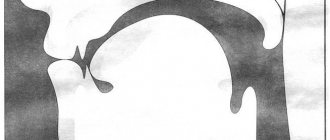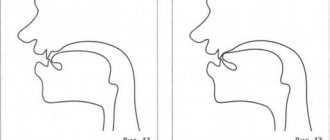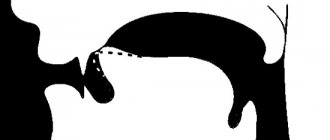If the child does not pronounce the sounds K, G, X, Y and others
Recently, many children, even at seven years old, have observed problems with the pronunciation of early sounds: [k], [g], [x], [th]. Also, many first-graders often soften consonants or voice deaf sounds and deafen voiced consonants. What is the reason and how to fix it, we will figure it out in this article.
| Correction of pronunciation disorders of back-lingual sounds |
| Sound setting [th] |
| Elimination of voicing and deafening defects |
Causes of violation of back-lingual and middle-lingual sounds
The sounds [k], [g], [x] are back-lingual in accordance with the place of formation. In their production, the main role is played by the back of the tongue, which tenses and presses against the palate. [Y] – middle language sound according to the place of formation. During its production, the middle third of the tongue tenses and rises towards the palate. Thus, language is very important when pronouncing these sounds.
One of the reasons for such a massive violation of the simplest sounds [k], [g], [x], [th] is the sluggishness of the tongue muscles. A generation of children is growing up, raised on artificial feeding and suckling at their mother’s breast for a short time. Breastfeeding is not only a natural process and a healthy diet, but also the formation of many mental functions. Among them are sexual components according to Freud and the development of the organs of the articulatory apparatus. When suckling at the breast, the baby tenses his barely formed muscles of the lips and tongue. The baby has to “obtain” milk on his own. With artificial feeding, less effort is applied. The nipple is less firm than the breast. Life becomes simpler, but this has a negative impact on strengthening the muscles of the tongue.
In addition, many newborns are now fed soft foods that have been softened in a blender. This is not good, because when chewing even small boiled potatoes, the muscles of the tongue are also trained. The child only swallows soft food; the tongue remains idle.
With normal development, the sounds [k], [g], [x], [th] should appear by the age of one year. Imagine how advanced the speech process is if by the age of seven they are gone. This means that in kindergarten the baby did not develop his tongue muscles. They didn’t play with him, clicking like a horse, babbling like a turkey, they didn’t crow with him like a rooster. A child learns to pronounce many sounds by imitating an adult.
Another cause of impaired pronunciation of back tongues is dysarthria, rhinolalia, and functional dyslalia.
Causes of voicing defects and deafening of sounds
These also include replacing hard consonants with soft ones. A voicing defect is when a child pronounces [b] instead of [p], [d] instead of [t], [k] is replaced by [g], [s] by [z]. Deafening defects are, on the contrary, the replacement of voiced consonants with voiceless ones. “Tom” instead of house, “kalka” instead of jackdaw, etc.
The cause of deafening and voicing of sounds is phonetic-phonemic speech disorder, dysarthria, open nasality, partial voice disorder, mild hearing loss. It is especially common in cases of phonemic hearing impairment. The cause of the latter disorder is birth injuries, infections during pregnancy, and brain injuries after the birth of a child. Certain areas of the brain are responsible for phonemic hearing, damage to which leads to these problems.
Correction of pronunciation disorders of back-lingual sounds
Violation of the pronunciation of sounds [k], [k'] is called kappacism, sounds [g], [g'] - gammatism, sounds [x], [x'] - hitism. If the above sounds are violated, you need to work on strengthening the muscles of the tongue. If the tongue is hypotonic, it is recommended to chew more from early childhood. For training, you can chew on a latex pacifier. Eat solid foods. Do exercises such as clicking - “horse”, “mountain” - arching the tongue, “painter” - raising the tongue to the “ceiling”, “woodpecker” - tapping the tip of the tongue at the upper teeth. The role of articulatory gymnastics is very important when producing any sounds.
When producing the sounds [k], [g], [x], the lips are open, the tip of the tongue is moved away from the teeth, the back of it is raised and pressed against the palate. When pronouncing [g], the work of the vocal cords is added; when producing [x], the back third of the tongue does not close with the palate, its lateral edges are pressed against the upper teeth.
When producing the sound [k], several methods are used:
|
The soft version of the sound [k] is made by imitation.
With gammatism, production is carried out through the sound [d]. The child pronounces the combinations: yes, yes, yes, the tip of the tongue is moved towards the throat with a spatula (you can use a finger or a spoon). Thus, the tongue moves away and produces the syllables: yes-gya-ga. The sound [g'] can also be placed by imitation.
The sound [x] is placed from the sound [s'] by the same pushing of the tongue back. The child says: sya-sya-sya, it turns out sya-hya-ha. Another way to do this is the “warm your palms” exercise. When exhaling air, the sound [x] is involuntarily produced. Soft [x'] - by imitation.
Consonant sounds [g], [g'], letters G, g
It's good outside the city, in the countryside. Fresh air, birds singing. This is where the parents brought the girl Galya to visit her grandfather. Gala is already 6.5 years old and will soon go to school. Grandfather loves his granddaughter, reads different fairy tales, and makes up stories. And today grandpa decided to tell Gala about the capital letter G
and a small
letter g
.
─ Galya, now we will get acquainted with the letter g
.
Look, your name begins with a hard consonant sound [g]
, and my name, Gena, begins with a soft consonant
sound [g']
.
These sounds in writing can be represented by a capital letter G
or a small
letter g
. For example, in the words newspaper and guitar.
Sounds [g]
and
[g']
are
consonant sounds
. Consonant sounds cannot be sung like vowels, and when we pronounce them, our lips or teeth or tongue prevent the air from passing freely in the mouth and an obstruction occurs.
Let's try to pronounce the sounds [g]
and
[g']
. The tongue makes it difficult to pronounce these sounds freely. This means they agree.
─ Grandfather, what’s the best way to remember hard consonant sounds and soft consonant sounds?
─ And in order to better remember these sounds, we will now perform an interesting task. I will tell you riddles, and you will draw the answers. Here are two pieces of paper for you.
On a blue piece of paper you will draw pictures whose names contain the hard sound [g]
, and on the light green one you will draw pictures whose names contain a soft
sound [g']
. And I'll check it later. So, let's begin.
Stands on one leg
He turns and turns his head,
Showing us countries
Rivers, mountains, oceans.
─ I know, this is a globe. Letter g
means a hard
sound [g]
, which means I’ll draw it on a blue piece of paper.
─ That's right, well done. Now another mystery.
Small, remote,
Passed through the earth
I found Little Red Riding Hood.
─ I know too, it’s a mushroom. The letter g in the word mushroom
means a hard
sound [g]
, which means I’ll draw it again on a blue piece of paper.
─ Here's another riddle.
We all love to listen
How Tamara sings with us,
And in her hands she is obedient
Six string…
─ Guitar. This is a riddle about my mother. Yes, she really likes to play the guitar. And in the word guitar the letter g
denotes a soft
sound [g']
.
─ And now the last mystery remains.
They hang from glass
Everything is burning with lights
They are having fun playing and decorating the Christmas tree.
─ Oh, this is a garland. In the word garland the letter g
denotes a soft
sound [g']
.
─ That's right. She’s so beautiful and sparkles with different lights.
─ All consonant sounds can sound voiced or unvoiced. Listen to how loudly the sounds [g] sound
and
[g']
. That's why we say they are voiced.
Capital letter G
and the small
letter g
are letters that should prompt us to pronounce
voiced paired sounds [g]
or
[g']
.
But in some words, instead of the sounds [g]
and
[g'],
we pronounce and hear
the sounds [k]
or
[k']
.
For example, in the word snow. We write the letter g
, but hear a hard consonant
sound [k]
.
─ Grandfather, how do you know which letter to write g
or
to
?
─ Very simple, granddaughter. We need to change the word so that after the letter g
there was a vowel.
For example: snow. You see, we hear the hard sound [g]
, so in the word snow we will write
the letter g
.
Now we will see how these letters are written.
Letter G
can be large (called
capital
) and small (called
lowercase
). A capital letter is always larger than a small letter, and a small letter is always smaller than a large letter.
─ Can I write these letters too?
─ Let’s draw it better. Here's a checkered piece of paper for you.
Please color the cells in the order to make the letter g
.
─ Well, Galya, we have learned to write the capital letter G
and a small
letter g
.
And now I will tell you in what cases the capital letter G
, and in which it is small.
Look, this is a photo of my dad or your great-grandfather.
His name was Gleb. He was a good doctor.
And this is my mother and your great-grandmother.
Her name is Glasha. And here is a photograph of the first cosmonaut.
This is Yuri Gagarin. All these names, patronymics and surnames of people are written with a capital letter
.
And this was our cat Gerasim.
Animal names are also written with a capital letter.
.
But we all vacationed together in the resort town of Gelendzhik.
─ Grandfather, you tell it so well. Let's do another interesting task.
─ Good. I’ll read you a little poem now, and then you’ll find and circle the big letter G
and a small
letter g
.
─ I see a big letter G
, and this is a small
letter g
.
─ That's right. And you must remember that a capital letter is written at the beginning of a sentence.
Well, we got acquainted with the hard sound [g]
and a soft
sound [g']
, which in writing are designated by
a capital letter G
and a small
letter g
.
The letter G can be compared to a poker:
Before us the letter G stands like a poker
And like a poker, the letter G humps its back.
And the letter g also looks like a braid.
Where the scythe walked, the field became bare.
Stages and sequence of sound production
The sequence of sounds in speech therapy is mainly determined over a long period of time. During the work, parents, speech therapists and, of course, the child himself participate. There is a certain system according to which the process of producing sounds is more effective.
The sequence of sound production in speech therapy is divided into the following stages:
- Preparation.
- Actually working on the production of sounds.
- Consolidating the correct sound pronunciation in a syllable, word, phrase, sentence (the principle is from simple to more complex).
- The difference between sounds, highlighting a specific sound, designating its place in a word.
You can move on to the next stage if the preschooler has no difficulties at this stage. If you neglect even minor errors, then in the future they will be much more difficult to correct.
You can set the sound in different ways:
- thanks to articulatory gymnastics and massage;
- imitating;
- mechanically (using speech therapy instruments - probes);
- from other sounds (many sounds are similar in articulation).
When does a child need sound correction?
Moms often understand better what her child is saying. However, speech defects, which many parents do not notice for a long time, can cause development and communication problems for the child in the future. Before you start panicking that the child does not speak a certain sound and take action, you need to find out what sounds should be formed at a certain age:
- Up to 3 years old, the baby correctly pronounces the sounds - B-B, M-M, V-V, P-P, T-T, D-D, K-K, G-G, H-H, F-F, N-NY, Y. Possible softening of sounds - this is considered the norm.
- From 3 to 4 years old, the child learns to pronounce S-S, Z-ZZ;
- At the age of 4-5 years, a preschooler masters Sh, Zh, Ch, Shch, Ts.
- At about 5-6 years old, a child can already say R-R-L, L-L correctly.
Now that age norms are known, we can make an assessment: how the child pronounces the sound, whether he distorts it, or replaces it with a simpler one. If a sound is pronounced incorrectly, then it is necessary to correct the sound pronunciation. The child needs to be tutored (by parents, speech therapist), without tutoring the pronunciation will be even worse.
The work of a speech therapist is divided into 3 stages:
- Sound production.
- Sound automation.
- Difference of sounds.
It is not recommended for parents to make sounds on their own; this should be done by a professional - a speech therapist. But from the 2nd stage, parents can continue the learning process at home.
If there are other disorders of the speech apparatus, then the child must be shown to a neurologist. Individual complex treatment will be prescribed.










